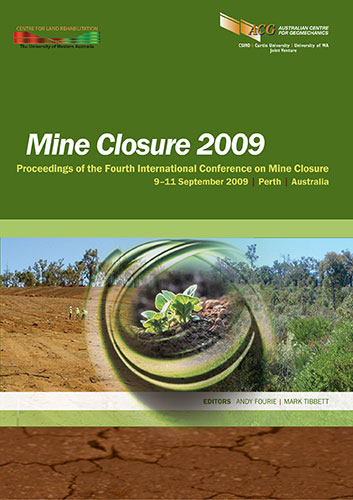Mine closure — participatory stakeholder engagement and socio-economic closure planning for community sustainability in the context of an uncertain future

|
Authors: Pollett, EA Paper is not available for download Contact Us |
DOI https://doi.org/10.36487/ACG_repo/908_31
Cite As:
Pollett, EA 2009, 'Mine closure — participatory stakeholder engagement and socio-economic closure planning for community sustainability in the context of an uncertain future', in AB Fourie & M Tibbett (eds), Mine Closure 2009: Proceedings of the Fourth International Conference on Mine Closure, Australian Centre for Geomechanics, Perth, pp. 417-428, https://doi.org/10.36487/ACG_repo/908_31
Abstract:
The preparation of environmental management plans to address the long-term effects of mining on the biophysical environment, rehabilitation and mine closure has now become best practice and the subject of mining authorisations. There is increasing recognition that there is a need for socio-economic closure planning at the outset, similar to that currently required for environmental management and rehabilitation. Stakeholder engagement and social management plans are key tools to ensure that adequate attention is given throughout the mine life cycle to the long-term effects of mine closure on affected communities and their socio-economic environment. Public consultation and transparency throughout the planning and implementation process are prerequisites for building mutually beneficial partnerships to deal with social change associated with mine development and eventual closure, and for ensuring sustainable community development in the context of an uncertain future. Mining is commonly a catalyst for local economic development and in remote areas often becomes the pre-dominant ‘economic engine’ of the region. However, minerals are a wasting resource, and there is a need to plan early on for ways in which to use the window of opportunity provided by mining to diversify the local economy so that it can provide a foundation for community sustainability in the longer term. This is particularly important where there is a high level of dependence on the mining sector. This paper addresses approaches to stakeholder engagement and socio-economic closure planning, drawing on the International Finance Corporation’s (IFC) Policy and Performance Standards on Social and Environmental Sustainability and experience with various mining projects in sub-Saharan Africa. In particular, reference is made to Sadiola Gold Mine in Mali which provides many lessons learned over a 14 year period. This includes a comprehensive ongoing stakeholder engagement and planning process with key role players, including local communities and civil society; local, regional and national government; the mine; international non-government organisations (NGOs) and the IFC. In particular, successful use has been made of participatory land use planning processes to address key spatial aspects, including (i) maximising the protection of limited available arable land (essential for continuity of agriculturally based livelihoods beyond mine closure); (ii) the accommodation of an influx of over 3,000 in-migrants following commencement of mine construction; (iii) the resettlement of two villages; and (iv) the preparation and implementation of an integrated development action plan (IDAP). Implementation of the IDAP is taking place in the context of an uncertain mine closure date which could take place in the short to medium term, and key challenges include maintaining sufficient implementation impetus to meet raised expectations, training and building local capacity to successfully implement the IDAP on an ongoing basis, especially after mine closure, and establishing long-term funding. The IDAP is providing a useful model of various integrated approaches to ensure that benefits and opportunities associated with mining activities are shared with local communities, and that local community development initiatives will endure beyond mine closure and result in long-term sustainable development.
References:
Filas, B.A. and Fohlen, D.W. (2000) World Bank Group Policies and Guidelines (Did Someone Move the Goal Posts?),
International Finance Corporation, Washington D.C., USA, paper (unpublished).
Giovannetti, F. and Pooley, J. (2004) Integrated Development Action Plan, Sadiola and Yatela Gold Mines, Mali,
International Finance Corporation, Washington D.C., USA, consultant report (unpublished).
Institute of Natural Resources (1998) Resettlement Action Plan, Sadiola and Farabakouta Villages, Sadiola Gold Mine,
Mali, Institute of Natural Resources Investigational Report 170, Pietermaritzburg, KwaZulu-Natal, South Africa,
consultant report (unpublished).
Mine closure — participatory stakeholder engagement and socio-economic closure E.A. Pollett
planning for community sustainability in the context of an uncertain future
428 Mine Closure 2009, Perth, Australia
Institute of Natural Resources (1997) Socio-Economic Study and Participatory Land-Use Planning for the Possible
Relocation of Sadiola and Farabakouta Villages, Sadiola Hill Gold Mine, Mali, Institute of Natural Resources
Investigational Report 152, Pietermaritzburg, KwaZulu-Natal, South Africa, consultant report (unpublished).
International Finance Corporation (2007) Stakeholder Engagement-A Good Practice Handbook for Companies Doing
Business in Emerging Markets, World Bank Group. Washington D.C., USA, 172 p.
International Finance Corporation (2006) Performance Standards on Social and Environmental Sustainability, World
Bank Group, Washington D.C., USA, 34 p.
International Finance Corporation (2003) Addressing the Social Dimensions of Private Sector Projects, Good Practice
Note, World Bank Group, Washington D.C., USA, 28 p.
International Finance Corporation (2002) Handbook for Preparing a Resettlement Action Plan, World Bank Group,
Washington D.C., USA, 80 p.
Middleton, J., Athie, M. and Pollett, E.A. (2002) The Approach of the IFC to Sustainable Mine Closure, International
Finance Corporation, Washington D.C., USA, paper (unpublished).
Pollett, E.A. (2006) Sadiola Foundaton, Mali-Challenges of an Integrated Development Approach to Ensure Sustainable
Development beyond Mine Closure, International Finance Corporation, Washington D.C., USA, workshop
presentation (unpublished).
Pollett, E.A. (2000) Mine Closure: Responsibilities and Community Sustainability, International Finance Corporation,
Washington D.C., USA, paper presented at the Southern Africa Workshop, Sustainable Development and the
Mining and Metal Industries, Johannesburg, South Africa (unpublished).
Solomon, M.H. (1997) Ready for the Fall? Downscaling in the Minerals Industry, Mineral and Energy Policy Centre,
Johannesburg, South Africa, Indicator SA Vol. 14, Johannesburg, p. 4.
World Bank Group (2003) The Final Report of the Extractive Industries Review, World Bank Group, Washington D.C.,
USA.
© Copyright 2025, Australian Centre for Geomechanics (ACG), The University of Western Australia. All rights reserved.
View copyright/legal information
Please direct any queries or error reports to repository-acg@uwa.edu.au
View copyright/legal information
Please direct any queries or error reports to repository-acg@uwa.edu.au